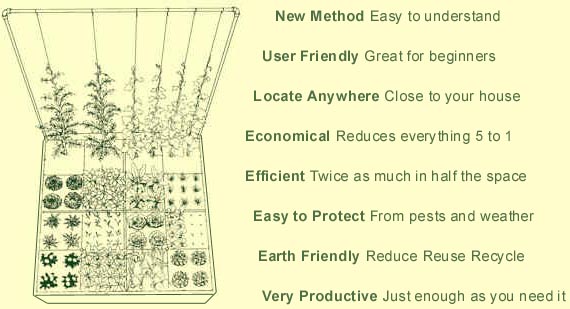Please show your support of Waihekepedia by adding a link to us from your web site. Waihekepedia T Shirts now available at the Ostend Market
Square foot gardening
Ken Clark is now running workshops on the Square Foot Gardening method, as recently seen in the Waiheke Marketplace.
Phone: 372 5258 for booking a place at the next workshop . Square foot gardening kitsets are now available
Square Foot Gardening is a uniquely simplified method of gardening that produces 100% of the harvest in only 20% of the space -- AND -- without all the hard work and drudgery of single row gardening.
Requires very little space; 80% less than conventional gardening. Can be done in as little as 4 feet by 4 feet, -- or as large as you want. Your existing (bad) soil doesn't matter because we don't use it. Start with an ideal soil mix that is weed-free and requires no tilling. Uses much less water; only about 20% compared to conventional gardening. No fertilizers or pesticides to handle -- it's all natural The planting method requires no thinning and very few seeds. All the hard work has been removed in the Square Foot method - only the enjoyable part remains. Can be started in any season. Produces 5 times the harvest of a conventional garden. Makes a great family project, all ages can participate - kids love to garden.
Ken holds the first workshop at his Erua Rd property, the square foot garden can be seen in the middle of the group. Photo:Waiheke Market Place/Megan Clark
Square Foot Gardening is a type of intensive gardening popularized by Mel Bartholemew. It is based on the idea that the wide rows in conventional home gardening are a waste of time, work, water and space, and that more quality vegetables can be grown in less space with less effort, no chemical additives, and on any type of ground, since the underlying soil is not used in the garden.
In this method, the garden space is divided into beds that are easily accessed from every side. A 4' x 4', 16 sq ft or 120cm x 120cm, 1.4m² garden is recommended for the first garden, and a path wide enough to comfortably work from should be made on each side of the bed, if possible, or if the bed must be accessed by reaching across it, a narrower one should be used so that no discomfort results from tending the garden. Each of the beds is divided into approximately one square foot units and marked out with sticks, twine, or sturdy slats to ensure that the square foot units remain visible as the garden matures.
Multiple square foot gardens in full swing
Different seeds are planted in each square, to ensure a rational amount of each type of crop is grown, and to conserve seeds instead of overplanting, crowding and thinning plants. Common spacing is one plant per square for larger plants (broccoli, basil, etc.), four plants per square for medium large plants like lettuce, nine plants per square for medium-small plants like spinach, and sixteen per square for small plants such as onions and carrots. Plants that normally take up yards of space as runners, such as squash or cucumbers, are grown vertically on sturdy frames that are hung with netting or string to support the developing crops. Ones that grow deep underground, such as potatoes or carrots, are grown in a square foot section that has foot tall sides and a planting surface above the ground, so that a foot or more of framed soil depth is provided above the garden surface rather than below it.
Graphic Illustration of what you can plant in the square foot grids
The beds are weeded and watered from the pathways, so the garden soil is never stepped on or compacted. Because a new soil mixture is used to create the garden, and a few handfuls of compost are added with each harvest to maintain soil fertility over time, the state of the site's underlying soil is irrelevant. This gardening method has been employed successfully in every region, including in deserts, on high arid mountain plateaus, in cramped city slums, and in areas with polluted or high salinity soils. It is equally useful for growing flowers, vegetables, herbs and some fruits in containers, raised beds, on tabletops or at ground level, in only 4 to 6 inches of soil. A few seeds per square foot, the ability to make compost, to water by hand, and to set up the initial garden in a sunny position or where a container, table or platform garden may be moved on wheels to receive light is all that is needed to set up a square foot garden.



